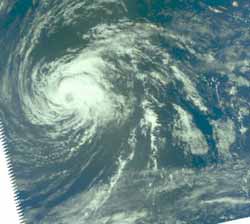Nadine bringing tropical storm conditions back to the Azores

NASA's Aqua satellite passed over Tropical Storm Nadine on Oct. 2 at 11:57 a.m. EDT and saw the strongest thunderstorms north and east of the center of circulation. Near-infrared data, which appears more like a visible image, still showed an eye-like feature.<br><br>Credit: NASA JPL/Ed Olsen<br>
A tropical storm warning is in effect for the Azores. The National Hurricane Center (NHC) expects tropical storm conditions associated with Nadine to spread over the northwestern Azores during the night hours on Wed. Oct. 3 and early Oct. 4.
NASA's Aqua satellite passed over Tropical Storm Nadine on Oct. 2 at 1517 UTC (11:57 a.m. EDT) and captured infrared and near-infrared images of the storm using the Atmospheric Infrared Sounder (AIRS) instrument. AIRS data showed the strongest thunderstorms were located north and east of the center of circulation. Near-infrared data, which appears more like a visible image, still showed an eye-like feature in the storm's center, despite its tropical storm status.
On Oct. 3 at 11 a.m. EDT, Tropical Storm Nadine had maximum sustained winds near 50 mph (85 kmh). It was centered about 405 miles (650 km) west-southwest of the Azores near latitude 35.1 north and longitude 33.3 west. Nadine was moving to the east at 14 mph (22 kph), and had a minimum central pressure of 1000 millibars.
Some weakening is forecast during the next two days, but Nadine is expected to still be a tropical storm when the center moves near or over the Azores, according to the NHC.
Nadine is battling wind shear and cooler sea surface temperatures, two factors that will make the storm transition into an extra-tropical cyclone. Wind shear is so strong over Nadine that the strongest thunderstorms and rainfall are pushed northeast of the center. The NHC forecast calls for Nadine to most likely become a post-tropical cyclone by Oct. 5 or sooner, before it becomes absorbed by a large extra-tropical cyclone.
Media Contact
More Information:
http://www.nasa.govAll latest news from the category: Earth Sciences
Earth Sciences (also referred to as Geosciences), which deals with basic issues surrounding our planet, plays a vital role in the area of energy and raw materials supply.
Earth Sciences comprises subjects such as geology, geography, geological informatics, paleontology, mineralogy, petrography, crystallography, geophysics, geodesy, glaciology, cartography, photogrammetry, meteorology and seismology, early-warning systems, earthquake research and polar research.
Newest articles

Silicon Carbide Innovation Alliance to drive industrial-scale semiconductor work
Known for its ability to withstand extreme environments and high voltages, silicon carbide (SiC) is a semiconducting material made up of silicon and carbon atoms arranged into crystals that is…

New SPECT/CT technique shows impressive biomarker identification
…offers increased access for prostate cancer patients. A novel SPECT/CT acquisition method can accurately detect radiopharmaceutical biodistribution in a convenient manner for prostate cancer patients, opening the door for more…

How 3D printers can give robots a soft touch
Soft skin coverings and touch sensors have emerged as a promising feature for robots that are both safer and more intuitive for human interaction, but they are expensive and difficult…




















